Workplace Diversity: Addressing Discrimination and Human Rights
VerifiedAdded on 2021/02/20
|9
|2019
|244
Report
AI Summary
This report explores the multifaceted aspects of workplace diversity, encompassing its definition, expressions, and the significance of fostering an inclusive environment. It delves into discriminatory practices, providing examples and explanations of their detrimental effects. The report highlights key human rights from the Universal Declaration of Human Rights, detailing potential breaches and emphasizing the importance of upholding these rights. Furthermore, it addresses historical and contemporary issues faced by Australia’s Aboriginal and Torres Strait Islander (ATSI) people, analyzing their impact on access to services. The report also presents a case study involving Jack and Jill, examining diversity-related issues that may contribute to their interactions. It explores the role of a support worker in such situations, emphasizing the provision of human rights and the application of effective communication skills, including accommodations for individuals with hearing impairments. The report concludes by reinforcing the importance of diversity and inclusion in the workplace.
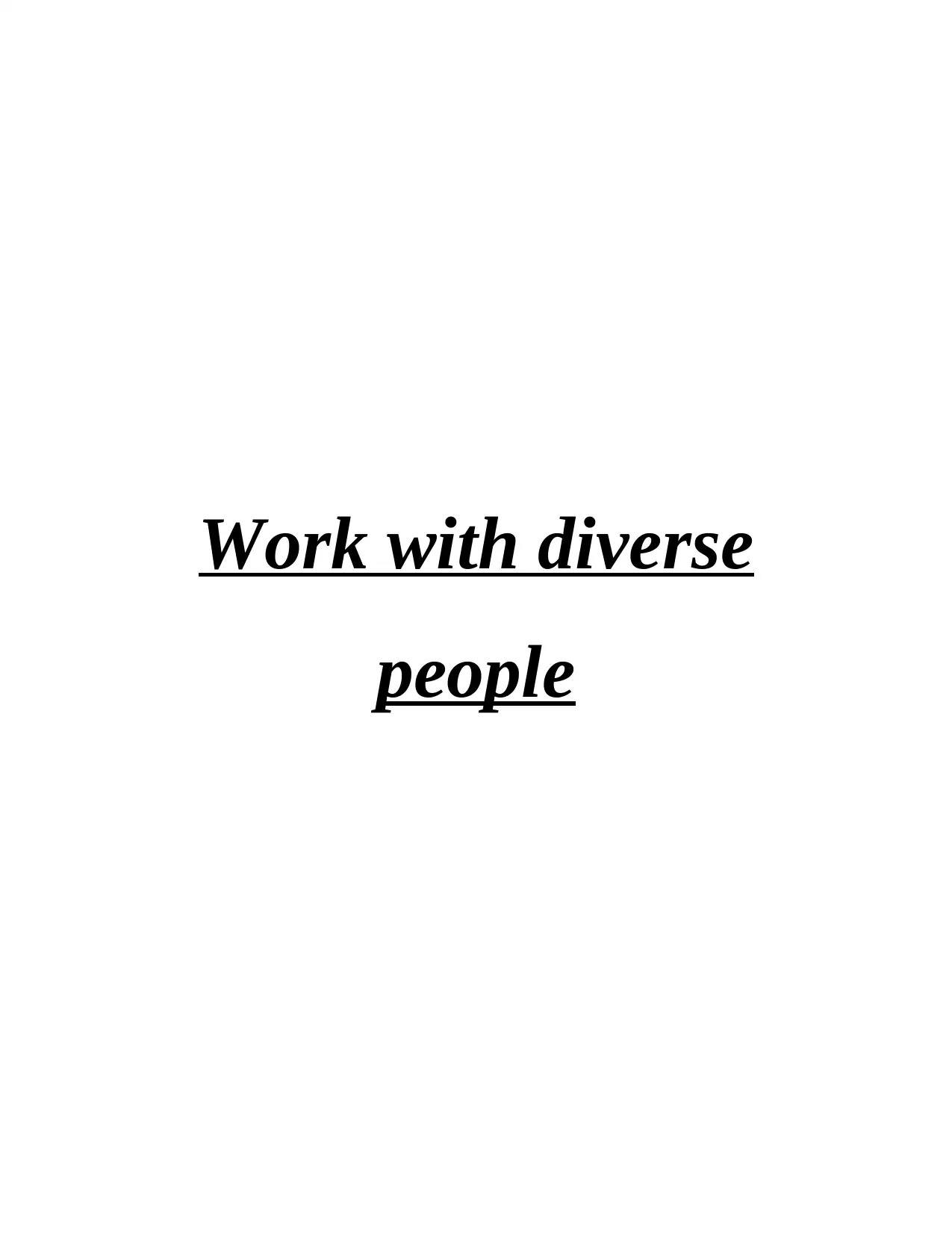
Work with diverse
people
people
Paraphrase This Document
Need a fresh take? Get an instant paraphrase of this document with our AI Paraphraser
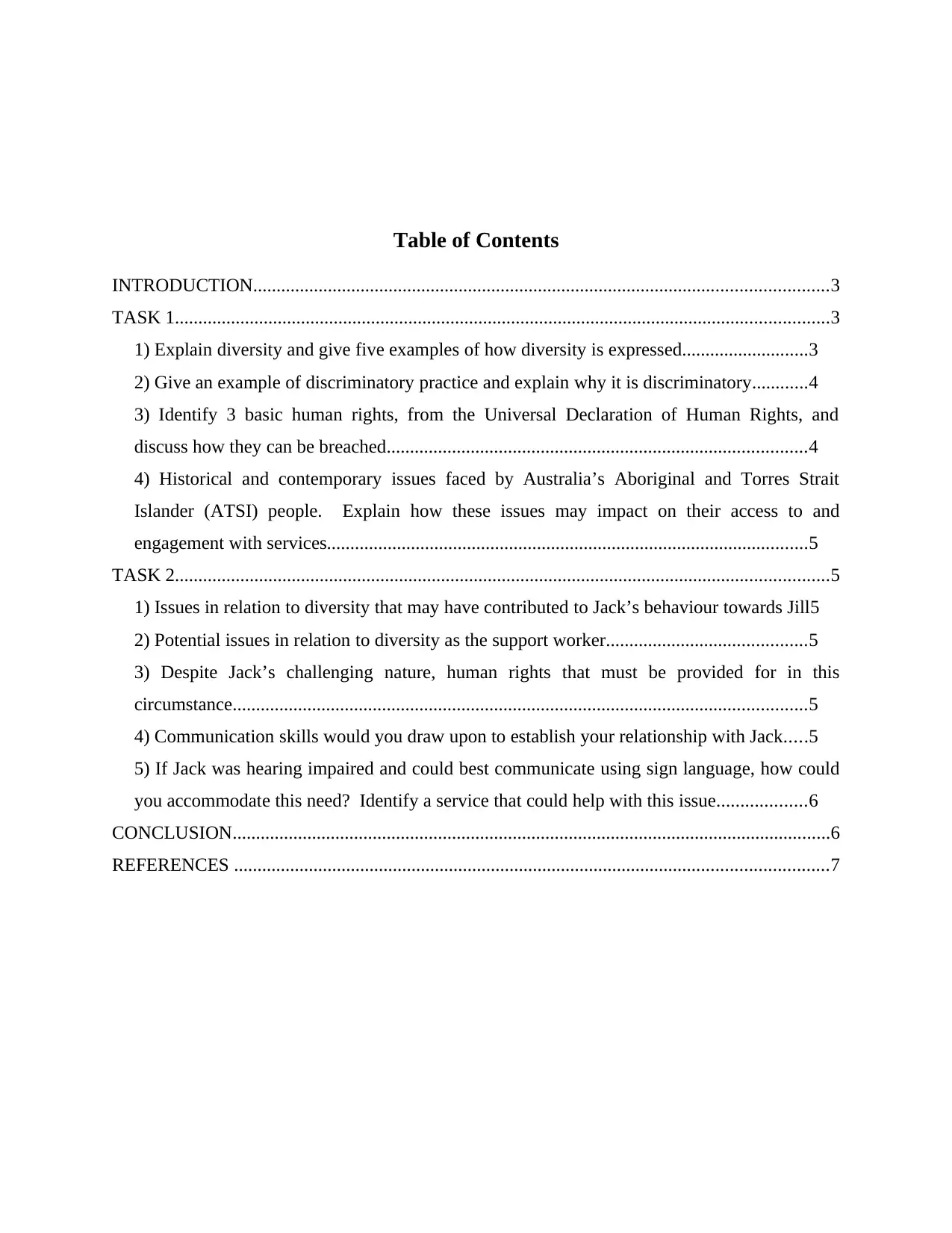
Table of Contents
INTRODUCTION...........................................................................................................................3
TASK 1............................................................................................................................................3
1) Explain diversity and give five examples of how diversity is expressed...........................3
2) Give an example of discriminatory practice and explain why it is discriminatory............4
3) Identify 3 basic human rights, from the Universal Declaration of Human Rights, and
discuss how they can be breached..........................................................................................4
4) Historical and contemporary issues faced by Australia’s Aboriginal and Torres Strait
Islander (ATSI) people. Explain how these issues may impact on their access to and
engagement with services.......................................................................................................5
TASK 2............................................................................................................................................5
1) Issues in relation to diversity that may have contributed to Jack’s behaviour towards Jill5
2) Potential issues in relation to diversity as the support worker...........................................5
3) Despite Jack’s challenging nature, human rights that must be provided for in this
circumstance...........................................................................................................................5
4) Communication skills would you draw upon to establish your relationship with Jack.....5
5) If Jack was hearing impaired and could best communicate using sign language, how could
you accommodate this need? Identify a service that could help with this issue...................6
CONCLUSION................................................................................................................................6
REFERENCES ...............................................................................................................................7
INTRODUCTION...........................................................................................................................3
TASK 1............................................................................................................................................3
1) Explain diversity and give five examples of how diversity is expressed...........................3
2) Give an example of discriminatory practice and explain why it is discriminatory............4
3) Identify 3 basic human rights, from the Universal Declaration of Human Rights, and
discuss how they can be breached..........................................................................................4
4) Historical and contemporary issues faced by Australia’s Aboriginal and Torres Strait
Islander (ATSI) people. Explain how these issues may impact on their access to and
engagement with services.......................................................................................................5
TASK 2............................................................................................................................................5
1) Issues in relation to diversity that may have contributed to Jack’s behaviour towards Jill5
2) Potential issues in relation to diversity as the support worker...........................................5
3) Despite Jack’s challenging nature, human rights that must be provided for in this
circumstance...........................................................................................................................5
4) Communication skills would you draw upon to establish your relationship with Jack.....5
5) If Jack was hearing impaired and could best communicate using sign language, how could
you accommodate this need? Identify a service that could help with this issue...................6
CONCLUSION................................................................................................................................6
REFERENCES ...............................................................................................................................7
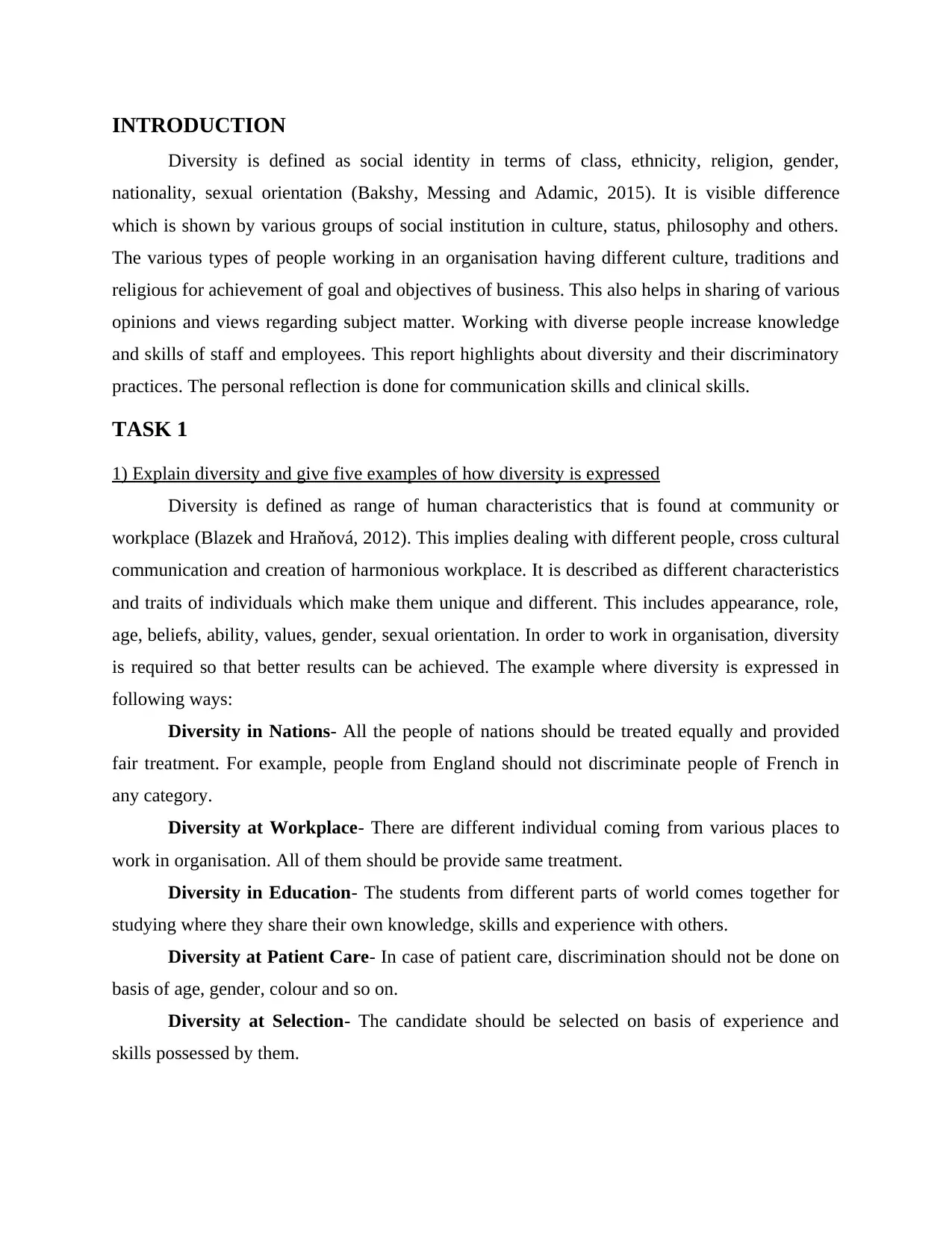
INTRODUCTION
Diversity is defined as social identity in terms of class, ethnicity, religion, gender,
nationality, sexual orientation (Bakshy, Messing and Adamic, 2015). It is visible difference
which is shown by various groups of social institution in culture, status, philosophy and others.
The various types of people working in an organisation having different culture, traditions and
religious for achievement of goal and objectives of business. This also helps in sharing of various
opinions and views regarding subject matter. Working with diverse people increase knowledge
and skills of staff and employees. This report highlights about diversity and their discriminatory
practices. The personal reflection is done for communication skills and clinical skills.
TASK 1
1) Explain diversity and give five examples of how diversity is expressed
Diversity is defined as range of human characteristics that is found at community or
workplace (Blazek and Hraňová, 2012). This implies dealing with different people, cross cultural
communication and creation of harmonious workplace. It is described as different characteristics
and traits of individuals which make them unique and different. This includes appearance, role,
age, beliefs, ability, values, gender, sexual orientation. In order to work in organisation, diversity
is required so that better results can be achieved. The example where diversity is expressed in
following ways:
Diversity in Nations- All the people of nations should be treated equally and provided
fair treatment. For example, people from England should not discriminate people of French in
any category.
Diversity at Workplace- There are different individual coming from various places to
work in organisation. All of them should be provide same treatment.
Diversity in Education- The students from different parts of world comes together for
studying where they share their own knowledge, skills and experience with others.
Diversity at Patient Care- In case of patient care, discrimination should not be done on
basis of age, gender, colour and so on.
Diversity at Selection- The candidate should be selected on basis of experience and
skills possessed by them.
Diversity is defined as social identity in terms of class, ethnicity, religion, gender,
nationality, sexual orientation (Bakshy, Messing and Adamic, 2015). It is visible difference
which is shown by various groups of social institution in culture, status, philosophy and others.
The various types of people working in an organisation having different culture, traditions and
religious for achievement of goal and objectives of business. This also helps in sharing of various
opinions and views regarding subject matter. Working with diverse people increase knowledge
and skills of staff and employees. This report highlights about diversity and their discriminatory
practices. The personal reflection is done for communication skills and clinical skills.
TASK 1
1) Explain diversity and give five examples of how diversity is expressed
Diversity is defined as range of human characteristics that is found at community or
workplace (Blazek and Hraňová, 2012). This implies dealing with different people, cross cultural
communication and creation of harmonious workplace. It is described as different characteristics
and traits of individuals which make them unique and different. This includes appearance, role,
age, beliefs, ability, values, gender, sexual orientation. In order to work in organisation, diversity
is required so that better results can be achieved. The example where diversity is expressed in
following ways:
Diversity in Nations- All the people of nations should be treated equally and provided
fair treatment. For example, people from England should not discriminate people of French in
any category.
Diversity at Workplace- There are different individual coming from various places to
work in organisation. All of them should be provide same treatment.
Diversity in Education- The students from different parts of world comes together for
studying where they share their own knowledge, skills and experience with others.
Diversity at Patient Care- In case of patient care, discrimination should not be done on
basis of age, gender, colour and so on.
Diversity at Selection- The candidate should be selected on basis of experience and
skills possessed by them.
⊘ This is a preview!⊘
Do you want full access?
Subscribe today to unlock all pages.

Trusted by 1+ million students worldwide
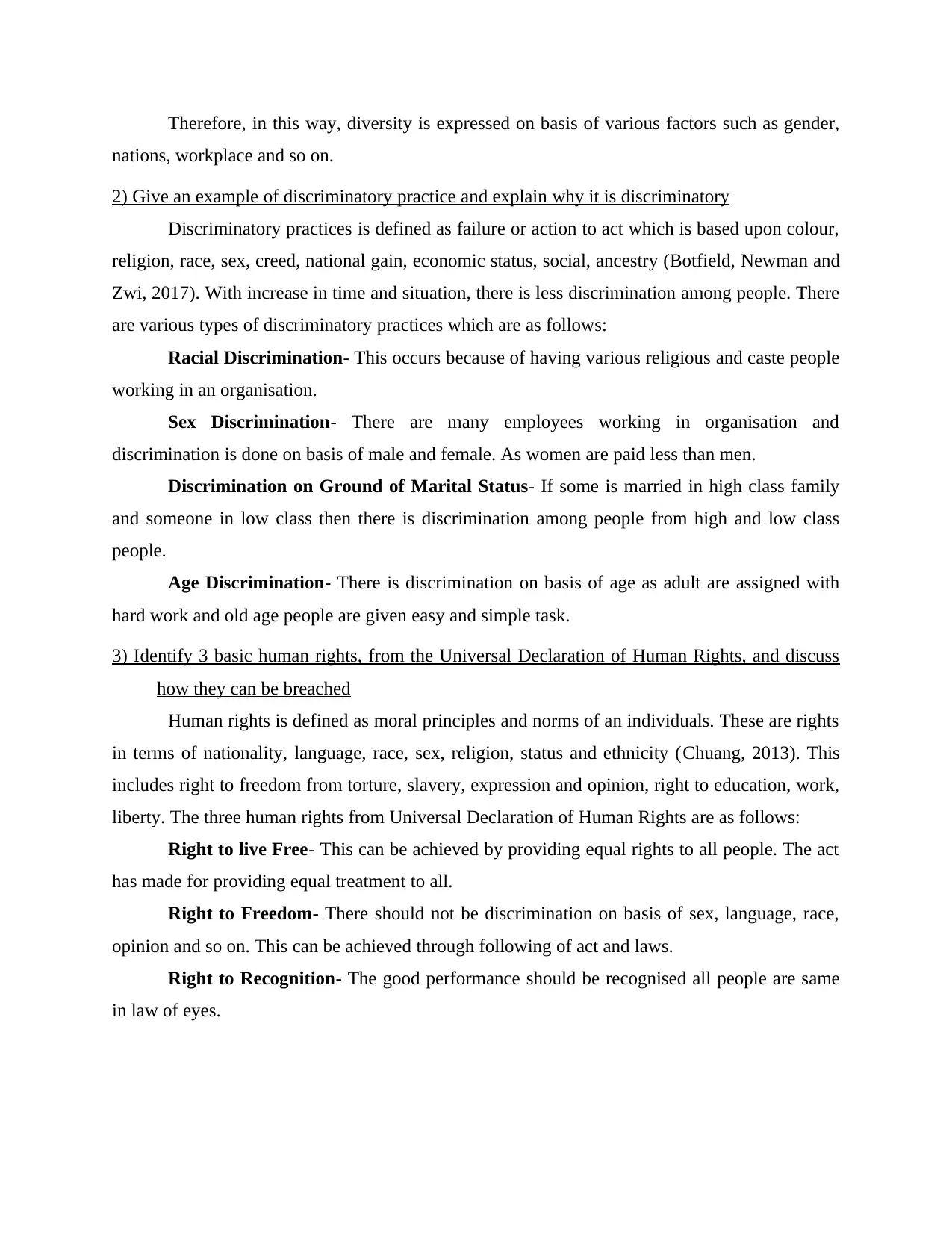
Therefore, in this way, diversity is expressed on basis of various factors such as gender,
nations, workplace and so on.
2) Give an example of discriminatory practice and explain why it is discriminatory
Discriminatory practices is defined as failure or action to act which is based upon colour,
religion, race, sex, creed, national gain, economic status, social, ancestry (Botfield, Newman and
Zwi, 2017). With increase in time and situation, there is less discrimination among people. There
are various types of discriminatory practices which are as follows:
Racial Discrimination- This occurs because of having various religious and caste people
working in an organisation.
Sex Discrimination- There are many employees working in organisation and
discrimination is done on basis of male and female. As women are paid less than men.
Discrimination on Ground of Marital Status- If some is married in high class family
and someone in low class then there is discrimination among people from high and low class
people.
Age Discrimination- There is discrimination on basis of age as adult are assigned with
hard work and old age people are given easy and simple task.
3) Identify 3 basic human rights, from the Universal Declaration of Human Rights, and discuss
how they can be breached
Human rights is defined as moral principles and norms of an individuals. These are rights
in terms of nationality, language, race, sex, religion, status and ethnicity (Chuang, 2013). This
includes right to freedom from torture, slavery, expression and opinion, right to education, work,
liberty. The three human rights from Universal Declaration of Human Rights are as follows:
Right to live Free- This can be achieved by providing equal rights to all people. The act
has made for providing equal treatment to all.
Right to Freedom- There should not be discrimination on basis of sex, language, race,
opinion and so on. This can be achieved through following of act and laws.
Right to Recognition- The good performance should be recognised all people are same
in law of eyes.
nations, workplace and so on.
2) Give an example of discriminatory practice and explain why it is discriminatory
Discriminatory practices is defined as failure or action to act which is based upon colour,
religion, race, sex, creed, national gain, economic status, social, ancestry (Botfield, Newman and
Zwi, 2017). With increase in time and situation, there is less discrimination among people. There
are various types of discriminatory practices which are as follows:
Racial Discrimination- This occurs because of having various religious and caste people
working in an organisation.
Sex Discrimination- There are many employees working in organisation and
discrimination is done on basis of male and female. As women are paid less than men.
Discrimination on Ground of Marital Status- If some is married in high class family
and someone in low class then there is discrimination among people from high and low class
people.
Age Discrimination- There is discrimination on basis of age as adult are assigned with
hard work and old age people are given easy and simple task.
3) Identify 3 basic human rights, from the Universal Declaration of Human Rights, and discuss
how they can be breached
Human rights is defined as moral principles and norms of an individuals. These are rights
in terms of nationality, language, race, sex, religion, status and ethnicity (Chuang, 2013). This
includes right to freedom from torture, slavery, expression and opinion, right to education, work,
liberty. The three human rights from Universal Declaration of Human Rights are as follows:
Right to live Free- This can be achieved by providing equal rights to all people. The act
has made for providing equal treatment to all.
Right to Freedom- There should not be discrimination on basis of sex, language, race,
opinion and so on. This can be achieved through following of act and laws.
Right to Recognition- The good performance should be recognised all people are same
in law of eyes.
Paraphrase This Document
Need a fresh take? Get an instant paraphrase of this document with our AI Paraphraser
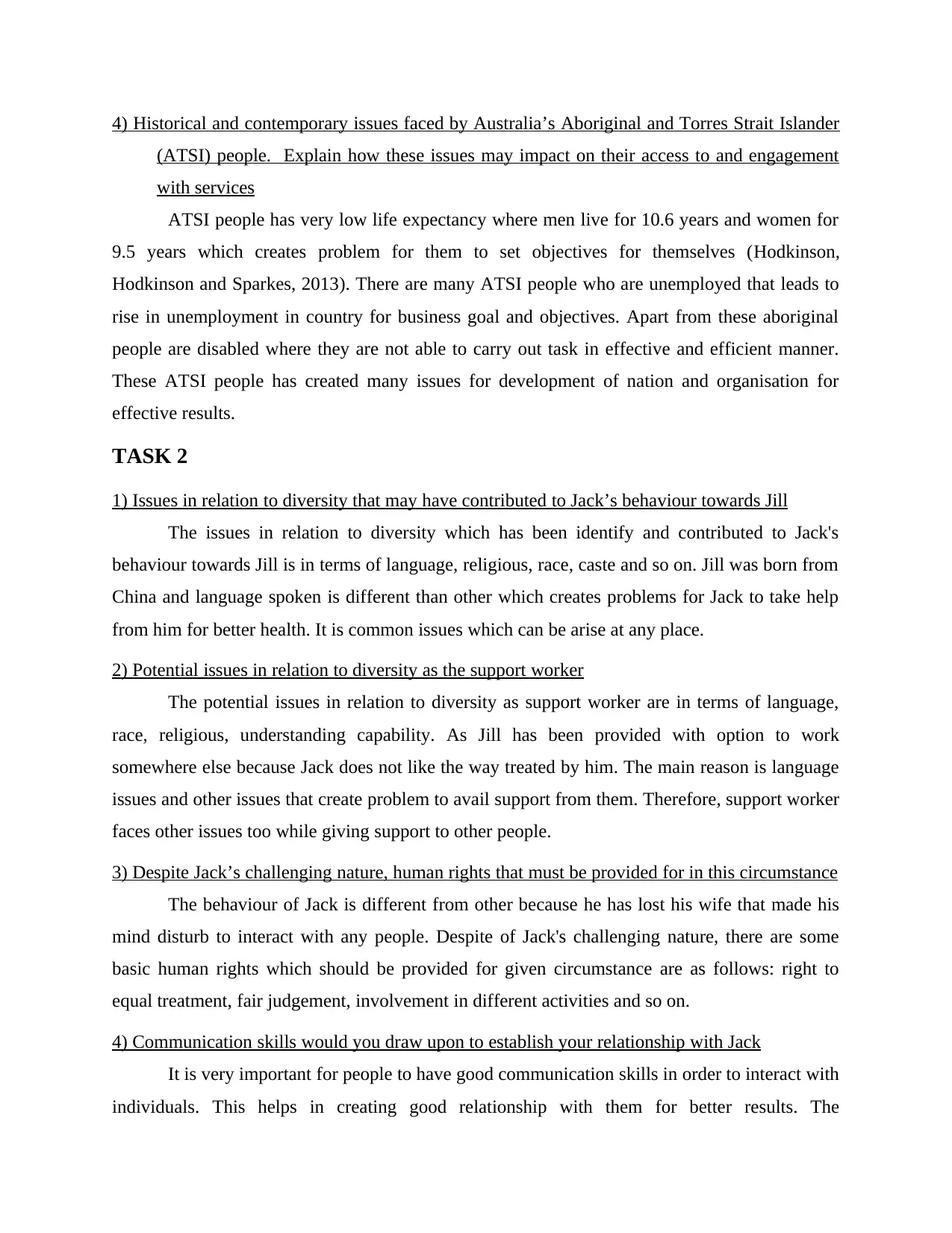
4) Historical and contemporary issues faced by Australia’s Aboriginal and Torres Strait Islander
(ATSI) people. Explain how these issues may impact on their access to and engagement
with services
ATSI people has very low life expectancy where men live for 10.6 years and women for
9.5 years which creates problem for them to set objectives for themselves (Hodkinson,
Hodkinson and Sparkes, 2013). There are many ATSI people who are unemployed that leads to
rise in unemployment in country for business goal and objectives. Apart from these aboriginal
people are disabled where they are not able to carry out task in effective and efficient manner.
These ATSI people has created many issues for development of nation and organisation for
effective results.
TASK 2
1) Issues in relation to diversity that may have contributed to Jack’s behaviour towards Jill
The issues in relation to diversity which has been identify and contributed to Jack's
behaviour towards Jill is in terms of language, religious, race, caste and so on. Jill was born from
China and language spoken is different than other which creates problems for Jack to take help
from him for better health. It is common issues which can be arise at any place.
2) Potential issues in relation to diversity as the support worker
The potential issues in relation to diversity as support worker are in terms of language,
race, religious, understanding capability. As Jill has been provided with option to work
somewhere else because Jack does not like the way treated by him. The main reason is language
issues and other issues that create problem to avail support from them. Therefore, support worker
faces other issues too while giving support to other people.
3) Despite Jack’s challenging nature, human rights that must be provided for in this circumstance
The behaviour of Jack is different from other because he has lost his wife that made his
mind disturb to interact with any people. Despite of Jack's challenging nature, there are some
basic human rights which should be provided for given circumstance are as follows: right to
equal treatment, fair judgement, involvement in different activities and so on.
4) Communication skills would you draw upon to establish your relationship with Jack
It is very important for people to have good communication skills in order to interact with
individuals. This helps in creating good relationship with them for better results. The
(ATSI) people. Explain how these issues may impact on their access to and engagement
with services
ATSI people has very low life expectancy where men live for 10.6 years and women for
9.5 years which creates problem for them to set objectives for themselves (Hodkinson,
Hodkinson and Sparkes, 2013). There are many ATSI people who are unemployed that leads to
rise in unemployment in country for business goal and objectives. Apart from these aboriginal
people are disabled where they are not able to carry out task in effective and efficient manner.
These ATSI people has created many issues for development of nation and organisation for
effective results.
TASK 2
1) Issues in relation to diversity that may have contributed to Jack’s behaviour towards Jill
The issues in relation to diversity which has been identify and contributed to Jack's
behaviour towards Jill is in terms of language, religious, race, caste and so on. Jill was born from
China and language spoken is different than other which creates problems for Jack to take help
from him for better health. It is common issues which can be arise at any place.
2) Potential issues in relation to diversity as the support worker
The potential issues in relation to diversity as support worker are in terms of language,
race, religious, understanding capability. As Jill has been provided with option to work
somewhere else because Jack does not like the way treated by him. The main reason is language
issues and other issues that create problem to avail support from them. Therefore, support worker
faces other issues too while giving support to other people.
3) Despite Jack’s challenging nature, human rights that must be provided for in this circumstance
The behaviour of Jack is different from other because he has lost his wife that made his
mind disturb to interact with any people. Despite of Jack's challenging nature, there are some
basic human rights which should be provided for given circumstance are as follows: right to
equal treatment, fair judgement, involvement in different activities and so on.
4) Communication skills would you draw upon to establish your relationship with Jack
It is very important for people to have good communication skills in order to interact with
individuals. This helps in creating good relationship with them for better results. The
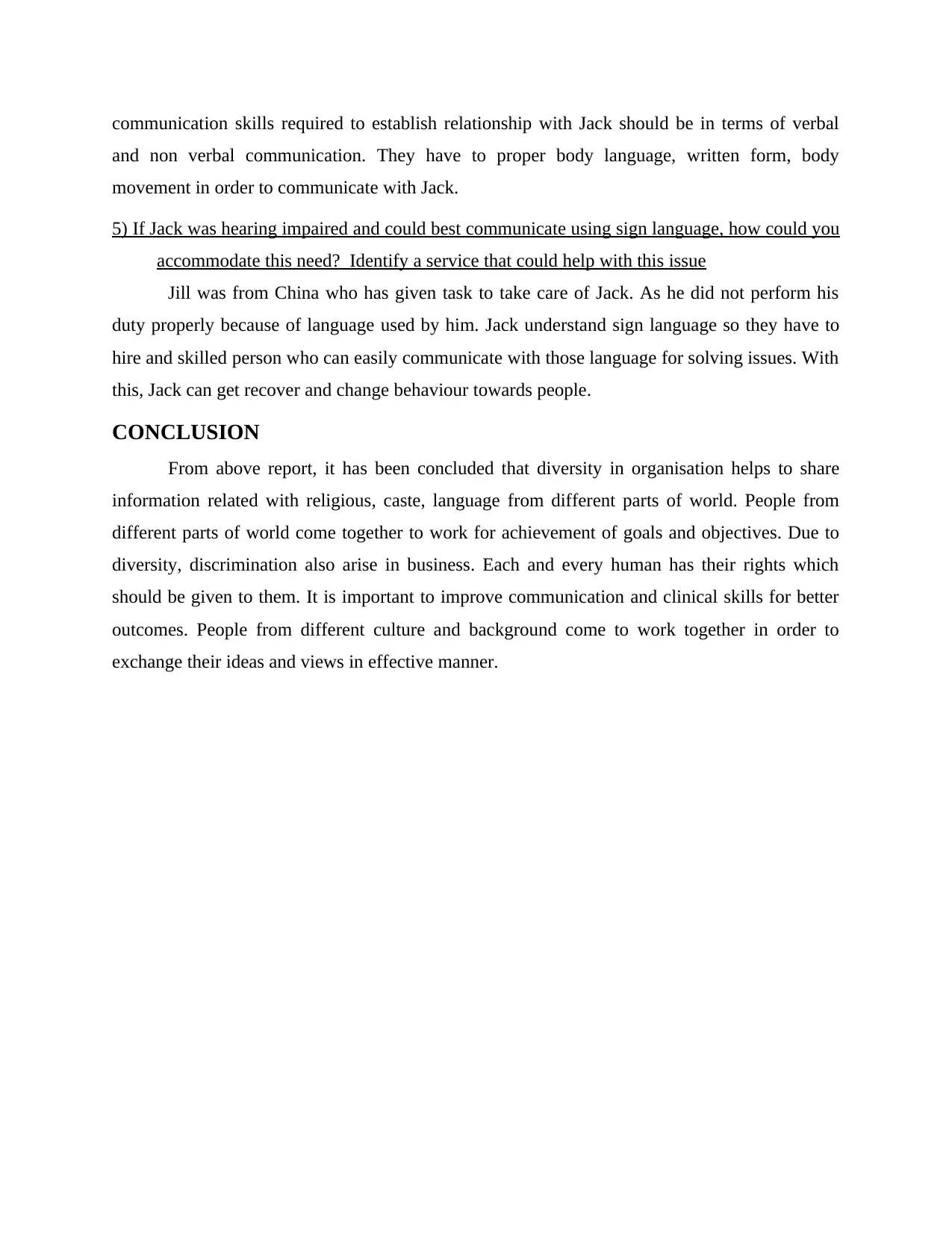
communication skills required to establish relationship with Jack should be in terms of verbal
and non verbal communication. They have to proper body language, written form, body
movement in order to communicate with Jack.
5) If Jack was hearing impaired and could best communicate using sign language, how could you
accommodate this need? Identify a service that could help with this issue
Jill was from China who has given task to take care of Jack. As he did not perform his
duty properly because of language used by him. Jack understand sign language so they have to
hire and skilled person who can easily communicate with those language for solving issues. With
this, Jack can get recover and change behaviour towards people.
CONCLUSION
From above report, it has been concluded that diversity in organisation helps to share
information related with religious, caste, language from different parts of world. People from
different parts of world come together to work for achievement of goals and objectives. Due to
diversity, discrimination also arise in business. Each and every human has their rights which
should be given to them. It is important to improve communication and clinical skills for better
outcomes. People from different culture and background come to work together in order to
exchange their ideas and views in effective manner.
and non verbal communication. They have to proper body language, written form, body
movement in order to communicate with Jack.
5) If Jack was hearing impaired and could best communicate using sign language, how could you
accommodate this need? Identify a service that could help with this issue
Jill was from China who has given task to take care of Jack. As he did not perform his
duty properly because of language used by him. Jack understand sign language so they have to
hire and skilled person who can easily communicate with those language for solving issues. With
this, Jack can get recover and change behaviour towards people.
CONCLUSION
From above report, it has been concluded that diversity in organisation helps to share
information related with religious, caste, language from different parts of world. People from
different parts of world come together to work for achievement of goals and objectives. Due to
diversity, discrimination also arise in business. Each and every human has their rights which
should be given to them. It is important to improve communication and clinical skills for better
outcomes. People from different culture and background come to work together in order to
exchange their ideas and views in effective manner.
⊘ This is a preview!⊘
Do you want full access?
Subscribe today to unlock all pages.

Trusted by 1+ million students worldwide
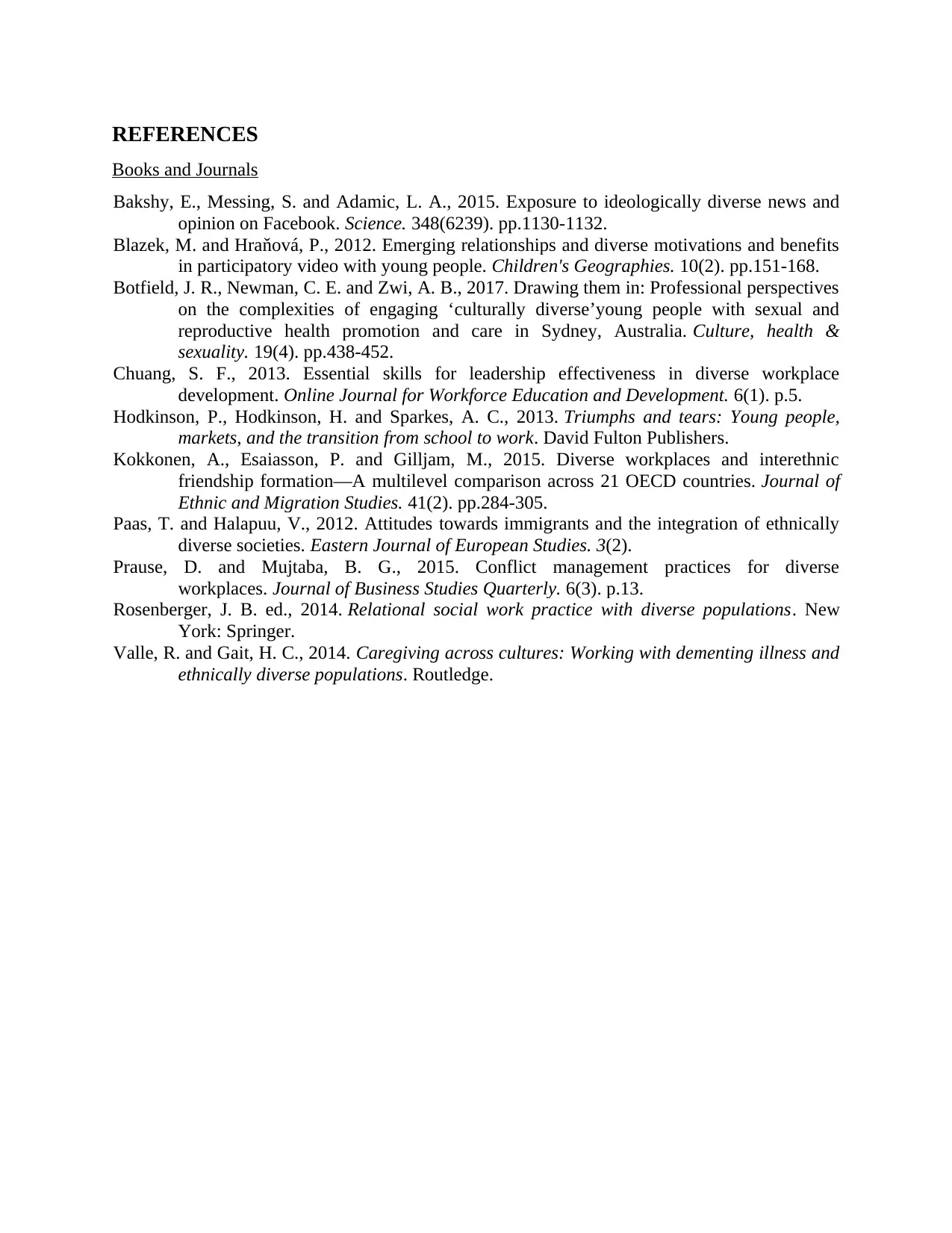
REFERENCES
Books and Journals
Bakshy, E., Messing, S. and Adamic, L. A., 2015. Exposure to ideologically diverse news and
opinion on Facebook. Science. 348(6239). pp.1130-1132.
Blazek, M. and Hraňová, P., 2012. Emerging relationships and diverse motivations and benefits
in participatory video with young people. Children's Geographies. 10(2). pp.151-168.
Botfield, J. R., Newman, C. E. and Zwi, A. B., 2017. Drawing them in: Professional perspectives
on the complexities of engaging ‘culturally diverse’young people with sexual and
reproductive health promotion and care in Sydney, Australia. Culture, health &
sexuality. 19(4). pp.438-452.
Chuang, S. F., 2013. Essential skills for leadership effectiveness in diverse workplace
development. Online Journal for Workforce Education and Development. 6(1). p.5.
Hodkinson, P., Hodkinson, H. and Sparkes, A. C., 2013. Triumphs and tears: Young people,
markets, and the transition from school to work. David Fulton Publishers.
Kokkonen, A., Esaiasson, P. and Gilljam, M., 2015. Diverse workplaces and interethnic
friendship formation—A multilevel comparison across 21 OECD countries. Journal of
Ethnic and Migration Studies. 41(2). pp.284-305.
Paas, T. and Halapuu, V., 2012. Attitudes towards immigrants and the integration of ethnically
diverse societies. Eastern Journal of European Studies. 3(2).
Prause, D. and Mujtaba, B. G., 2015. Conflict management practices for diverse
workplaces. Journal of Business Studies Quarterly. 6(3). p.13.
Rosenberger, J. B. ed., 2014. Relational social work practice with diverse populations. New
York: Springer.
Valle, R. and Gait, H. C., 2014. Caregiving across cultures: Working with dementing illness and
ethnically diverse populations. Routledge.
Books and Journals
Bakshy, E., Messing, S. and Adamic, L. A., 2015. Exposure to ideologically diverse news and
opinion on Facebook. Science. 348(6239). pp.1130-1132.
Blazek, M. and Hraňová, P., 2012. Emerging relationships and diverse motivations and benefits
in participatory video with young people. Children's Geographies. 10(2). pp.151-168.
Botfield, J. R., Newman, C. E. and Zwi, A. B., 2017. Drawing them in: Professional perspectives
on the complexities of engaging ‘culturally diverse’young people with sexual and
reproductive health promotion and care in Sydney, Australia. Culture, health &
sexuality. 19(4). pp.438-452.
Chuang, S. F., 2013. Essential skills for leadership effectiveness in diverse workplace
development. Online Journal for Workforce Education and Development. 6(1). p.5.
Hodkinson, P., Hodkinson, H. and Sparkes, A. C., 2013. Triumphs and tears: Young people,
markets, and the transition from school to work. David Fulton Publishers.
Kokkonen, A., Esaiasson, P. and Gilljam, M., 2015. Diverse workplaces and interethnic
friendship formation—A multilevel comparison across 21 OECD countries. Journal of
Ethnic and Migration Studies. 41(2). pp.284-305.
Paas, T. and Halapuu, V., 2012. Attitudes towards immigrants and the integration of ethnically
diverse societies. Eastern Journal of European Studies. 3(2).
Prause, D. and Mujtaba, B. G., 2015. Conflict management practices for diverse
workplaces. Journal of Business Studies Quarterly. 6(3). p.13.
Rosenberger, J. B. ed., 2014. Relational social work practice with diverse populations. New
York: Springer.
Valle, R. and Gait, H. C., 2014. Caregiving across cultures: Working with dementing illness and
ethnically diverse populations. Routledge.
Paraphrase This Document
Need a fresh take? Get an instant paraphrase of this document with our AI Paraphraser


⊘ This is a preview!⊘
Do you want full access?
Subscribe today to unlock all pages.

Trusted by 1+ million students worldwide
1 out of 9
Related Documents
Your All-in-One AI-Powered Toolkit for Academic Success.
+13062052269
info@desklib.com
Available 24*7 on WhatsApp / Email
![[object Object]](/_next/static/media/star-bottom.7253800d.svg)
Unlock your academic potential
Copyright © 2020–2025 A2Z Services. All Rights Reserved. Developed and managed by ZUCOL.





